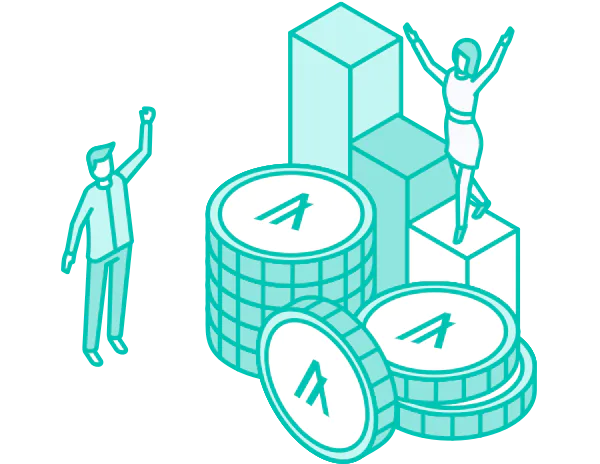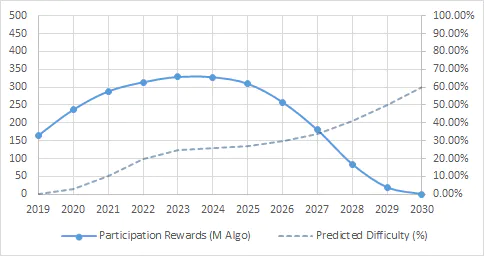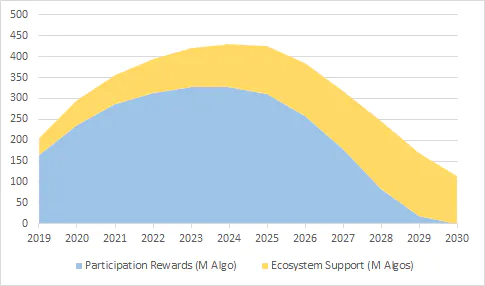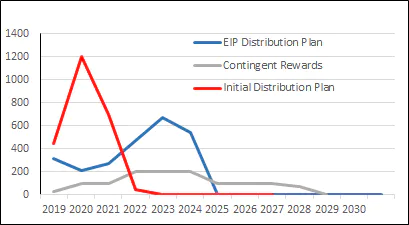10 Year Algo Diffusion into Circulating Supply
By building this 10-year program, the Foundation is providing clarity on how the outstanding supply of Algo will enter into circulation. By 2030, the Foundation expects over 99% of all Algo minted at Genesis to be in Circulating Supply according to a non-inflationary distribution rate. The “Circulating Supply” is the total supply of Algo that is available on-chain without contract restrictions. It is defined as the Total Supply less tokens held in restricted wallets (future vesting of rewards, future grants, participation rewards pools, contingent incentives, etc).
The paradigm we will follow in the 10-year Plan is diffusion of the Algo with gradual creation of long term digital scarcity. The diffusion has been planned to be faster when an even faster activity and economic development is expected. This is detailed below.
Community Incentives: Participation Rewards
For the 2.5 Billion Participation Rewards, of which 300M have already been distributed, the distribution plan aims at keeping rewards competitive in the next few years, while letting digital scarcity kick in later.
For 2021 and 2022 the Foundation has allocated an amount of Algos to Participation Rewards which is around 8% of the pool receiving such rewards, which translates into a reward potentially much higher than 8% for those committing to participate in governance and lock their tokens for a longer term.
When the rewards total annual amount starts decreasing, we expect the difficulty (i.e. locking time required to participate to governance) of the services required to receive rewards (participation in governance and associated commitment) to increase, reducing the pool receiving rewards while keeping rewards competitive as a percentage of the size of the receiving pool.
Ecosystem Support
The 1.25 Billion Algo allocated to Ecosystem Support will be locked and distributed, under smart contract, periodically over 10 years at the rate of approximately 10% per year. In the next months the amounts will be allocated to new and existing partners (decentralization) but will remain locked and gradually released via smart contracts. This will ensure that the release required to raise the funds supporting the ecosystem is smooth and non-inflationary. Because of the gradual decentralization of the funds, we expect that the implementation will be 60% at the end of 2021 and growing to reach 90% in the following three years. This will make the distribution sustainable and non-inflationary. In fact, the distribution will be lower in the first years and larger in the last ones, balancing the reduced distribution over time of the participation rewards.
This distribution achieves a slow gradual release in the first years and subsequent increase in the rate of distribution more easily absorbed by an already large and developing market, supported also by the economic activity fueled by the Ecosystem Support Program itself.
The Ecosystem Support effort shows different categories. Let us add some details about them:
- The 250M Foundation Algo Grant Program is already running at the Foundation, with approximately 50M Algo already committed and dozens of projects already at work. For the remaining part the focus will be on the development of the infrastructure above the protocol, and there will be an increasing role for the community in the choice of the projects to finance, through several rounds of blockchain voting.
- The involvement of the community will also apply to the 400M Algo Innovation Fund, to be built in partnership with selected regional organisations, external to the Foundation and of proven credentials, that will then select the projects with the highest probability of business success. The allocation is ongoing.
- The Research and Social Good program will be implemented through individual partnership with universities, public institutions and private companies. This 200M Algo will be gradually moved to partners throughout 2021 and 2022.
- The R&D fund for Protocol Development, R&D and Capital Markets is implemented as a 400M Algo partnership with Algorand Inc., aiming at a continuous expansion of the protocol and at the creation of the right conditions for the usage of the Algo currency and of the rest of the blockchain’s native or tokenized value. ~70M Algo have already been spent in the initial development effort, the remaining 330M Algo will be in parallel with the developments coming from our decentralized ecosystem.
Community Incentives: Early Backers / Relay Nodes
In the chart, we show how the initial distribution to Early Backers / Relay Nodes group would have resulted in a significant spike in supply between 2020 and 2021, while the market was immature.
EIP-11252019AF was proposed by the Early Backers / Relay Node community as a solution to this problem and the vote on this passed, bringing our current distribution plan into effect. The distribution of
Contingent Rewards to Super Staking Participants and to Early Backer / Relay Node Runners affected by EIP-11252019AF was part of the same process of economic reform.
Some of the buckets in the new allocation require some further details:
- While Early Backers / Relay Node runner and participation rewards are already known to the Algorand community, the 1200 Million allocated to Contingent Incentives need clarification. This fund has actually already been allocated for the most part, but to projects with different names: participants in the Super Staking program and Early Backers / Relay Node Runners affected by the Economic Improvement Proposal EIP-11252019AF will receive 800M from this fund in the next years, and the fund includes also the approximately 25M that were burned at the end of the Auction Refund . All these initiatives addressed the supply issues that emerged in the first months, and aligned the interest of participants to the community. For example EIP-11252019AF introduced an economically virtuous link between Early Backers / Relay Node rewards distribution and the market trend. The remaining amount of 380 M is kept as a locked reserve to address similar needs that could emerge in the future.
 archived 16 Feb 2021 14:56:48 UTC
archived 16 Feb 2021 14:56:48 UTC archived 16 Feb 2021 14:56:48 UTC
archived 16 Feb 2021 14:56:48 UTC







